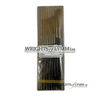Gold Leaf Across the World - Malta
- by Sam Wozniak
The Radiant Legacy of Gold Leaf in Malta
Gold leaf has long been intertwined with Malta’s rich artistic and architectural traditions. Made by hammering gold into ultra-thin sheets, this material has been prized for its visual brilliance, symbolic power, and lasting durability. Across Malta, from cathedrals to civic emblems, gold leaf—particularly in 24 carat and 23.5 carat forms—has been used in gilding practices that elevate both religious devotion and monumental design.
Historical Roots of Gilding in Malta
Malta’s central location in the Mediterranean brought a confluence of cultural and artistic influences, especially during the rule of the Knights of St. John (1530–1798). These elite warrior-monks transformed Malta into a hub of Baroque art and architecture, where gilding became a defining aesthetic feature. Gold leaf was used to signal divine majesty and imperial power, with 24 carat and 23.5 carat gold sheets applied meticulously to altars, statues, and ceilings.
24 Carat Gold Leaf: A Symbol of Sacred Perfection
Pure 24 carat gold leaf, with its unrivalled lustre and incorruptibility, became a powerful symbol of heavenly perfection. Its use was most prominent in ecclesiastical spaces, where the material’s purity reflected the eternal nature of the divine. The process of gilding these sacred spaces was not just decorative, but deeply spiritual—an offering to God through artistry.
The Monumental Splendour of St. John’s Co-Cathedral
Nowhere is gold leaf more gloriously showcased than at St. John’s Co-Cathedral in Valletta. Constructed in the late 16th century, this masterpiece of Baroque architecture is a monumental tribute to the power and piety of the Knights of St. John. Inside, nearly every inch is adorned with gold leaf, particularly 24 carat, applied through traditional gilding techniques to altarpieces, sculptural details, and ceiling motifs. The visual effect is breath taking—a sea of shimmering gold that speaks to both opulence and reverence.
23.5 Carat Gold Leaf: Practical Elegance and Durability
While 24 carat gold leaf is the most radiant, 23.5 carat gold leaf offers a slightly more practical solution for certain applications. It maintains a high level of purity and brilliance but includes a trace of alloy, providing added strength. In Malta, 23.5 carat gold is often chosen for surfaces exposed to wear or environmental conditions—such as outdoor emblems, architectural mouldings, or frequently handled religious artifacts.
Gilding Beyond the Church Walls
Gold leaf isn’t confined to religious buildings. Malta’s civic architecture, government buildings, and noble residences have also embraced gilding. Coats of arms, ceremonial inscriptions, and ornamental details were often gilded to display wealth and authority—particularly during British colonial rule and earlier periods of aristocratic influence. The result is a landscape dotted with gold-highlighted monumental features that echo the island's layered history.
Traditional Artisanship and Village Festas
Another key setting for gold leaf in Malta is in the village festas, celebrated across the island. Religious statues paraded during these festivals often feature gold-gilded halos, crowns, and garments. These decorations are carefully applied by skilled local artisans using traditional gilding methods and either 23.5 or 24 carat leaf. This keeps the craft alive and maintains the spiritual and visual integrity of these treasured icons.
Preserving Malta’s Gilded Heritage
Today, both public and private initiatives are working to restore and preserve Malta’s gilded masterpieces. Skilled artisans are in high demand for restoration projects in churches, museums, and historical sites. By using authentic materials—whether 23.5 or 24 carat gold leaf—Malta ensures that its monumental artworks and architecture continue to shine, just as they did centuries ago.
Conclusion
Gold leaf, in both its 24 and 23.5 carat forms, remains an enduring part of Malta’s cultural identity. From the gilded ceilings of cathedrals to the ornamental details of village celebrations, gilding has helped define Malta’s architectural and spiritual landscape. Through centuries of monumental craftsmanship, gold leaf continues to reflect Malta’s radiant history—and its commitment to preserving beauty, tradition, and meaning.






